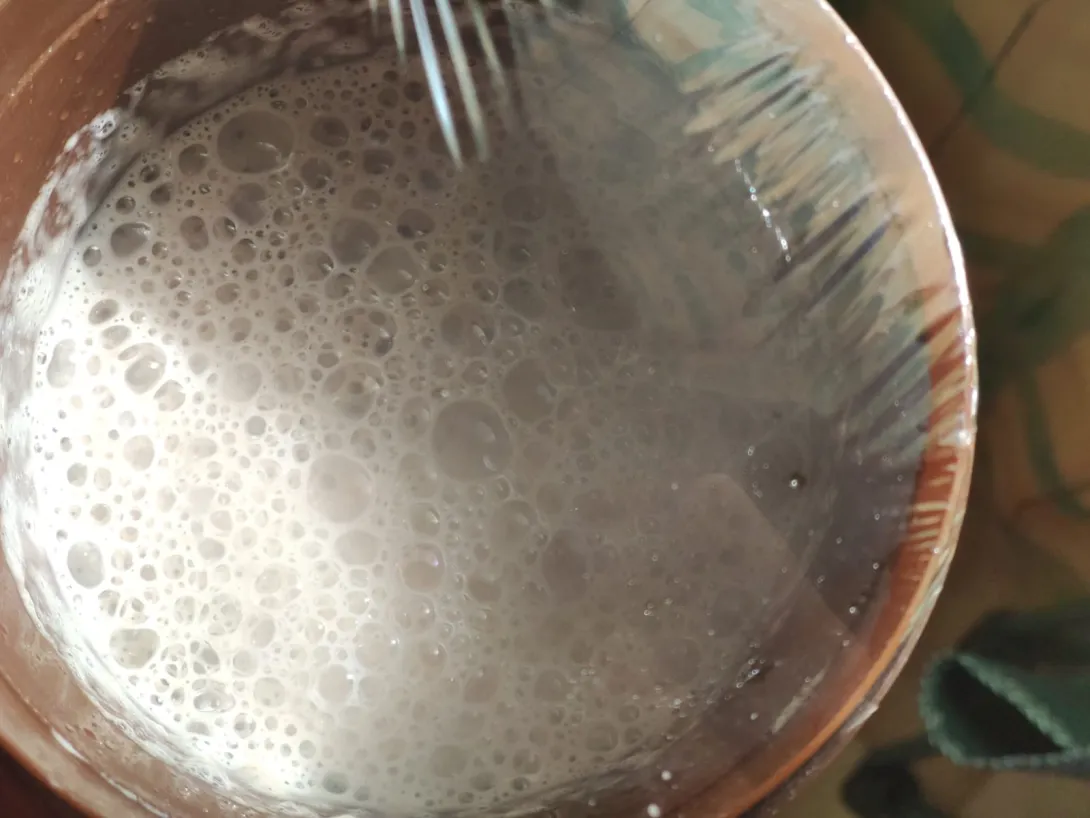
I just started experimenting with probiotic capsules containing heterofermentative bacteria. After the first 12 hours of waiting, I fed them again.
Here Ingredients:
Lactobacillus Acidophilus 3,0 Billion CFU
Bifidobacterium Longum 2,5 Billion CFU
Bifidobacterium Bifidum 0,5 Billion CFU
Bifidobacterium Infantis 0,5 Billion CFU
Lactobacillus Rhamnosus 0,5 Billion CFU
Lactobacillus Bulgaricus 0,5 Billion CFU
Lactobacillus Paracasei 0,5 Billion CFU
Lactobacillus Brevis 0,5 Billion CFU
Lactobacillus Reuteri 0,5 Billion CFU
Streptococcus Thermophilus 0,5 Billion CFU
Lactobacillus Plantarum 0,5 Billion CFU
Inulin 1.250mg
and after 2 feeds, I added a little sprinkle of Saccharomyces cerevisiae.
Today is 3th day and It's smells like orange and very foamy on top. I'm looking for analyses.
I'm feeding them with whole wheat flour.
Something tells me these bacteria like warm temperature around 37C. Are you keeping your starter warm?
They are in average ~27°C
Welcome aboard.
Nice experiment! I'm a tinkerer too, and sometimes like to "play mad scientist."
My latest is "making" buttermilk by propagating the cultures from store-bought buttermilk with plain milk, then letting it sit at room temp overnight. Someone, I forget who, showed me this link:
http://benstarr.com/blog/all-about-buttermilk/
My "homemade buttermilk" also increases in tanginess just sitting in the fridge. I've tinkered by adding some yogurt and cream cheese.
--
Two of the real bread and microbiology experts here who I admire are:
https://www.thefreshloaf.com/user/mariana
and:
https://www.thefreshloaf.com/user/debra-wink
Hopefully, they will soon chime in.
--
About yeast-vs-LAB, Mariana linked to a video, and wrote a good comment here:
https://www.thefreshloaf.com/comment/486405#comment-486405
Debra Wink's microbiology expertise is on display in these two posts:
https://www.thefreshloaf.com/node/10856/pineapple-juice-solution-part-1
https://www.thefreshloaf.com/node/10901/pineapple-juice-solution-part-2
Part 1 is super technical, Part 2 is more how-to about getting a starter going for the average home-kitchen baker.
--
All I can offer is this: commercial Saccharomyces Cerevisiae is not a species of yeast that loves to live in symbiosis with the various acid producing bacteria. For that, you need one or more of the wild yeast species that are known to inhabit the surface of grains (such as wheat and rye) or fruit (such as grapes).
I think your system could work, but if it does, what may happen is this: As the Saccharomyces Cerevisiae slowly dies off, it is also being replaced by feeding the ongoing starter with flour that is bringing in species of wild yeast that do love the LAB.
This is similar to what is recommended in the Poilane book: make a LAB/yeast starter out of yogurt, white flour, and WW flour, and commercial (Saccharomyces Cerevisiae) yeast. But if the starter is maintained/fed long enough, the LAB and wild yeast brought in by the flour that is fed to it, eventually take over.
Dave makes a valid point about the yeasts. Seems logical with numerous feedings the wild yeasts that prefer an acidic environment would take over. And while I also love to experiment if this takes as long as the traditional way to make a starter then nothing has been gained. It's still very interesting though.
I'm also under the impression that while the yeasts and bacteria in a sourdough/starter are varied and many it won't make a good home for every type of yeast and bacteria. So while you have thrown at it many lab grown bacteria it'll find an equilibrium. And on top of that you also find that one type of bacteria with accompanying yeast tends to be the more dominant ones at any one time.
I just remembered another example of someone seeding a sourdough starter with one tiny individual granule of commercial bread yeast.
In the Laurel's Kitchen Bread Book, updated edition copyrighted 2003, pages 150 - 151, "Manuel's Rye Sour."
She says the 1/2 tsp milk and literally one granule of yeast really made a difference, and that they tried it both with and without them.
Here's a similar approach you might find interesting:
https://www.thefreshloaf.com/node/59912/sour-dough-ferments-using-probiotics
Thank you for having me here, and for your answers.
I'm making my first bread today with this starter.
I'll post the result after it's cooked.
By the way, is it possible for you to tell me a few wild yeast strains that I can research? I love researching about fermentation things.
Some are listed here: https://en.wikipedia.org/wiki/Sourdough
Whoops!, it just came out. And it didn't spread the way I wanted.
I'll slice it when it cools.
I used ~450 gr flour (starter included) and %~60-77 hydration (I have no scale right now)
What do you think?
It has a veeery veeery sour taste!
Not sur it’s worth it TBH with a less than stellar rise and a taste you don’t seem convinced by. I guess an experiment is never a total waste- chalk it down to experience.